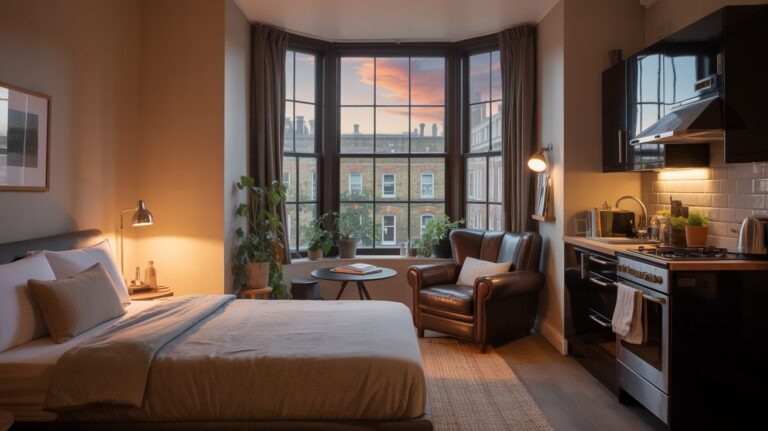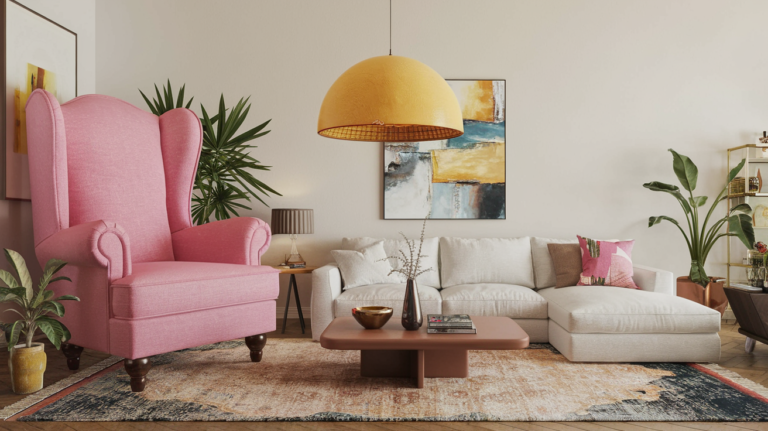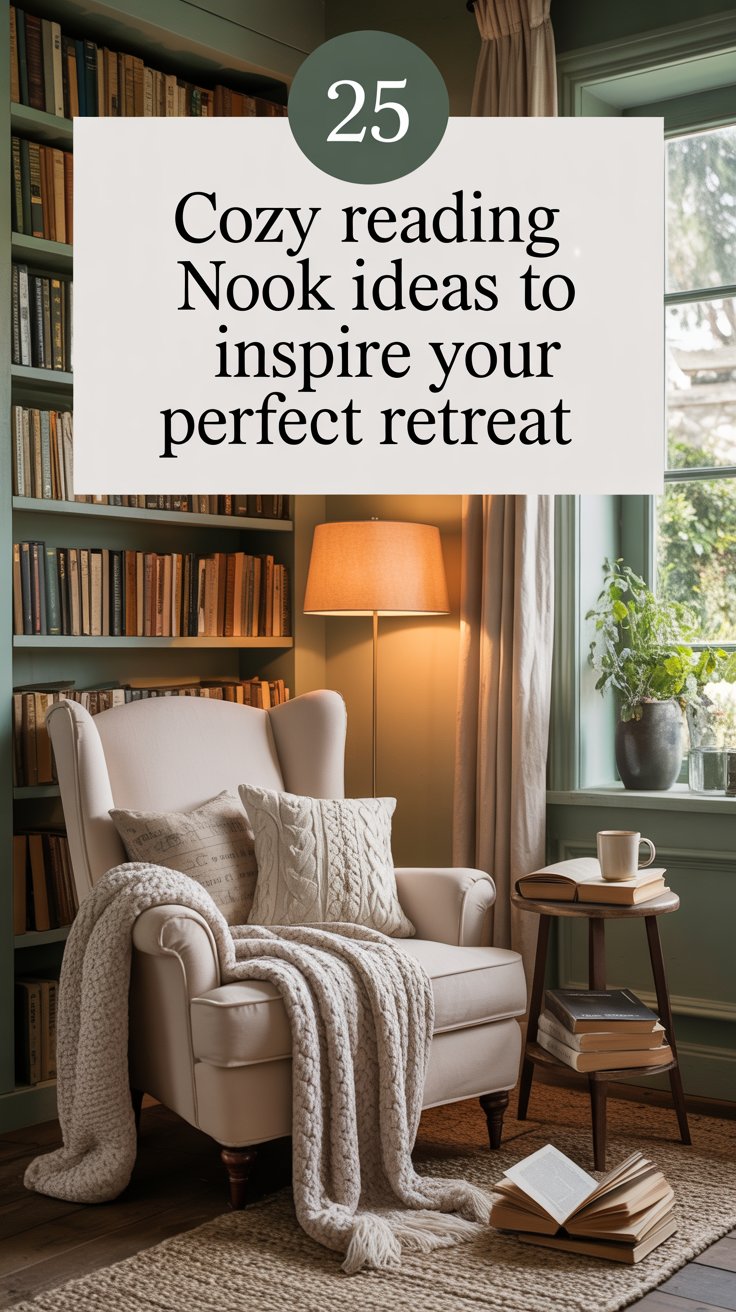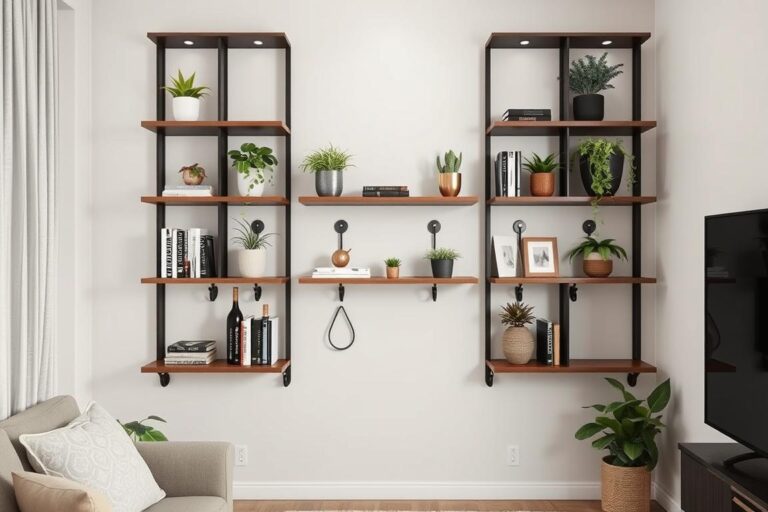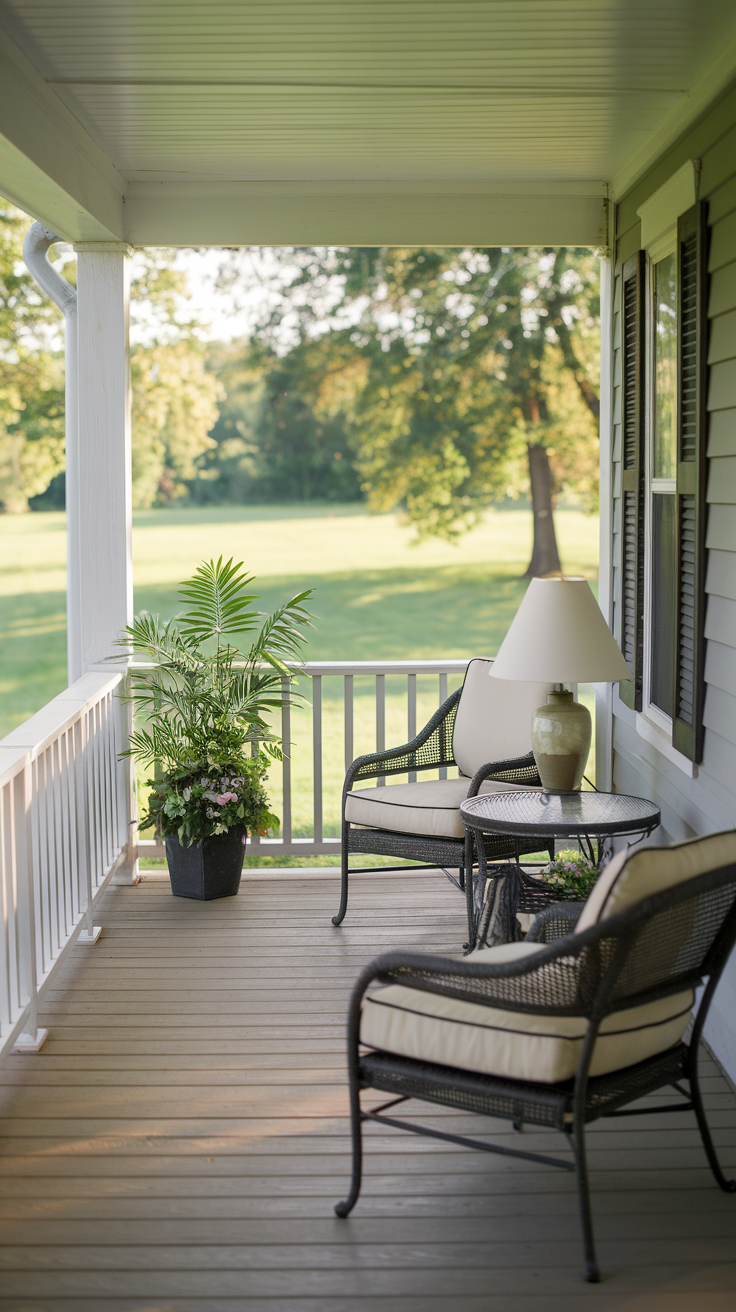Discover How to Style a Summer-Inspired Sunroom
Did you know 72% of homeowners say natural light is their top priority when designing living spaces? Your sunroom holds untapped potential to become the brightest, most inviting area in your home. With thoughtful choices, this transitional space can shift from a casual morning coffee spot to an elegant evening gathering hub.
Sunrooms thrive on balance. They blend indoor comfort with outdoor energy through strategic design choices. The right furniture acts as an anchor, while breezy textiles and organic materials create movement. Imagine linen curtains dancing in warm air currents beside potted palms soaking up afternoon rays.
Color plays a vital role in seasonal transitions. Soft terracotta tones mirror sunset hues, while seafoam greens echo coastal vistas. These shades work harmoniously with wooden accents and rattan details, crafting spaces that feel both fresh and timeless.
Key Takeaways
- Maximize natural light through strategic window treatments and reflective surfaces
- Choose flexible furniture that supports relaxation and social interaction
- Incorporate weather-resistant natural materials for lasting summer appeal
- Use layered textiles to balance sunlight intensity throughout the day
- Anchor the space with statement plants that thrive in bright environments
Embrace Natural Light and Airy Vibes
Sunlit spaces have a unique way of elevating mood and expanding perceived boundaries in your home. Designers like Carmel Brantley often treat light as the foundation of sunroom design, using it to shape atmosphere rather than merely illuminate. In Florida residences, retractable floor-to-ceiling windows dissolve barriers between indoor and outdoor spaces, letting breezes carry the scent of blooming jasmine through the room.
Light-colored walls act as canvases for shifting daylight. Opt for pale oat or whisper-gray tones that amplify brightness without glare. Pair these with matte-finish furniture legs or satin-metal accents to create subtle contrast. Many homeowners find success with unlined linen drapes that filter sunlight while maintaining privacy—a trick borrowed from cozy living spaces where comfort meets elegance.
Strategic emptiness proves vital. Leave breathing room between seating areas and incorporate reflective surfaces like glass side tables. Floridian designs often use motorized solar shades that vanish when not needed, preserving sightlines to palm fronds swaying beyond the glass. These choices foster an environment where spring’s freshness lingers year-round, anchored by potted ferns or air plants in geometric terrariums.
For those seeking subtle updates: replace heavy throw pillows with feather-filled cotton covers, or swap dark rug borders for sisal mats with tonal patterns. The goal? A space that feels deliberately uncluttered yet warmly inhabited—where light dictates the room’s rhythm.
Incorporate Bold Paint Colors and Accents
Bold hues transform sunrooms from functional spaces to emotional anchors. Design expert Julie Soefer champions oxblood in high-gloss finishes for its depth-enhancing properties. “A rich wall color acts like jewelry for architecture,” she notes, suggesting these tones work particularly well in rooms flooded with natural light.
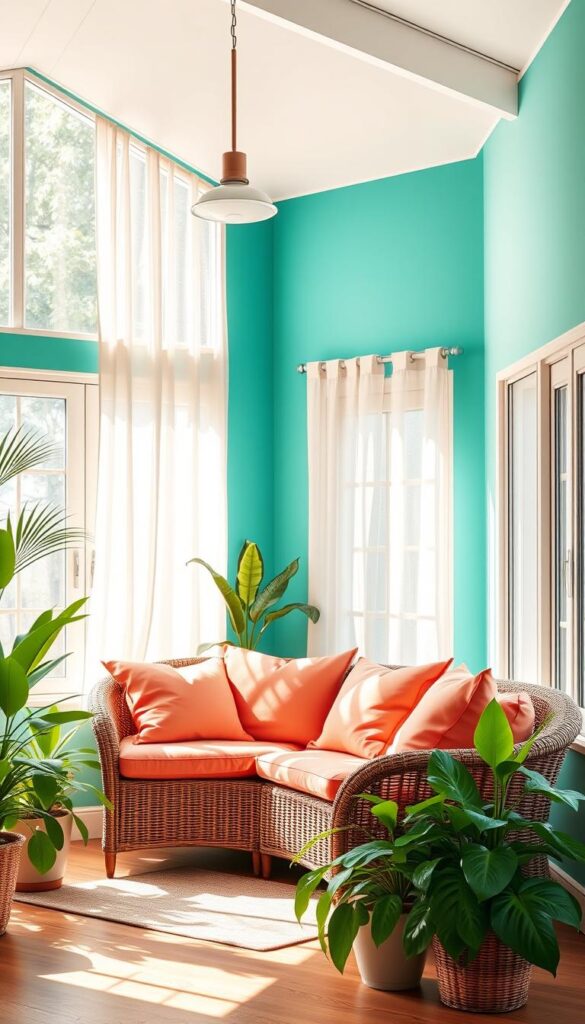
High-Gloss vs. Matte Finishes
Glossy surfaces amplify sunlight’s dance across walls, creating dynamic reflections that shift throughout the day. Matte options absorb light, offering velvety sophistication. For north-facing spaces, consider satin finishes—they provide gentle luminosity without overwhelming glare.
Bold Trim Options for Impact
Aimée Mazzenga’s charcoal-black window casings demonstrate how contrasting trim frames views while grounding airy layouts. Try navy-blue baseboards against oyster-white walls, or terracotta crown molding for warmth. These details add architectural weight without darkening the room’s core.
Test paint samples at different times before committing. Morning light reveals truer undertones, while afternoon sun intensifies chroma. Pair daring walls with neutral furnishings—a sand-colored sofa or rattan coffee table balances vibrancy. This approach lets color command attention while maintaining harmony with your home’s overall decor.
Invest in Versatile Sunroom Furniture
The right furniture transforms sunrooms from seasonal spaces to year-round retreats. Designers like Bunny Williams champion pieces that bridge indoor comfort and outdoor durability. Your choices should celebrate natural light while standing up to humidity and temperature shifts common in these transitional areas.
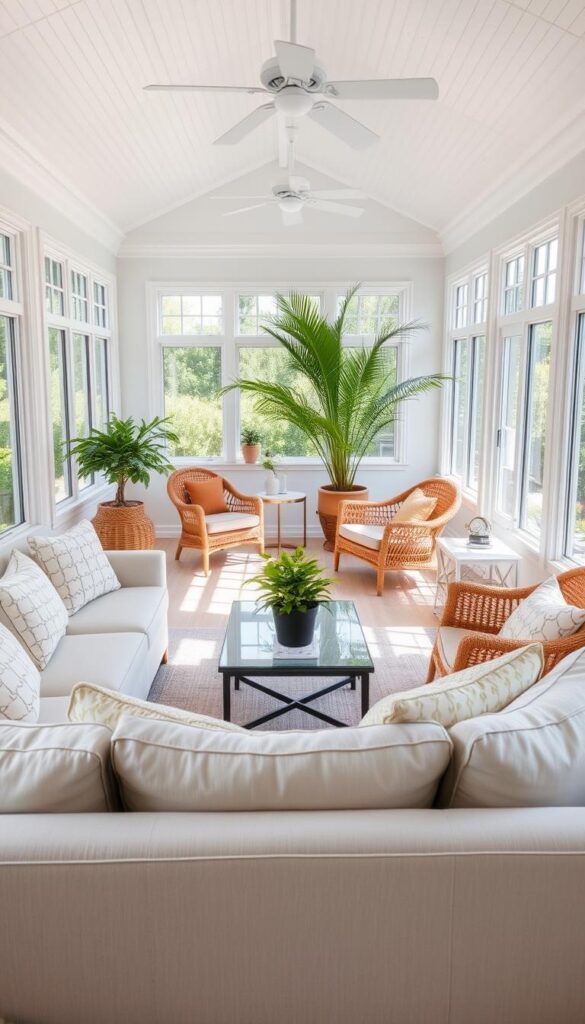
Wicker and Rattan Recommendations
Natural materials anchor sunroom designs with organic texture. Wicker furniture offers lightweight flexibility, while rattan provides structural integrity. These materials age gracefully, developing a soft patina that aligns with relaxed summer living.
Look for modular sectionals from Serena & Lily that reconfigure for gatherings or solo lounging. Polywood’s weather-resistant wicker dining sets withstand UV exposure without fading—ideal for breakfast nooks. Interior designer Sheila Bridges often pairs curved rattan chairs with plush cushions, proving functionality needn’t sacrifice elegance.
Consider multi-use designs like Lulu and Georgia’s storage ottomans that serve as coffee tables or extra seating. Custom banquettes with built-in planters maximize space efficiency, blending greenery with seating arrangements. These solutions honor the sunroom’s dual role as sanctuary and social hub.
Balance creative flair with practical needs. A teak-and-rattan daybed works equally well for afternoon naps or evening cocktails. Prioritize pieces offering clean lines and neutral tones, allowing bold accents to come from throw pillows or surrounding foliage.
Create a Cozy Reading and Relaxation Zone
Your sunroom deserves a corner dedicated to quiet moments. Designers Brittany Ambridge and Erin Sander Design agree: thoughtful seating arrangements transform underused areas into personal retreats. Start by positioning a plush armchair near windows where daylight naturally pools—a perfect spot to enjoy your favorite novel.
Layer Up with Cushions and Throws
Comfort begins with tactile layers. Drape a chunky knit throw over your chair’s armrest, then pile lumbar pillows in linen and velvet behind you. This creates depth while supporting posture during long reading sessions. For cooler mornings, keep a folded cotton blanket nearby—practical and visually inviting.
Morning light sets the mood. Install adjustable sconces or a slender floor lamp to complement natural brightness. Designers often use dimmable fixtures near seating areas, allowing you to shift from crisp daylight reading to softer evening ambiance effortlessly.
Mix textures to engage multiple senses. Try a wool rug underfoot paired with smooth leather ottomans. Add a side table with enough surface space for coffee mugs and book stacks. Woven baskets tucked beneath store extra blankets or magazines, keeping your retreat clutter-free.
Choose furniture that invites lingering. A deep-seated loveseat with washable slipcovers works well for shared spaces. In smaller rooms, opt for a compact chaise lounge with built-in storage. These choices ensure your reading zone feels intentional yet adaptable—a true extension of your home’s personality.
Select Unique Window Treatments
Window treatments act as both functional armor and artistic expression in sunrooms. Designers Deborah Costa and Kristine Renee champion designs that harmonize privacy with sunlight diffusion, creating spaces where light feels curated rather than controlled. Your choices here set the tone for how the room interacts with shifting daylight.
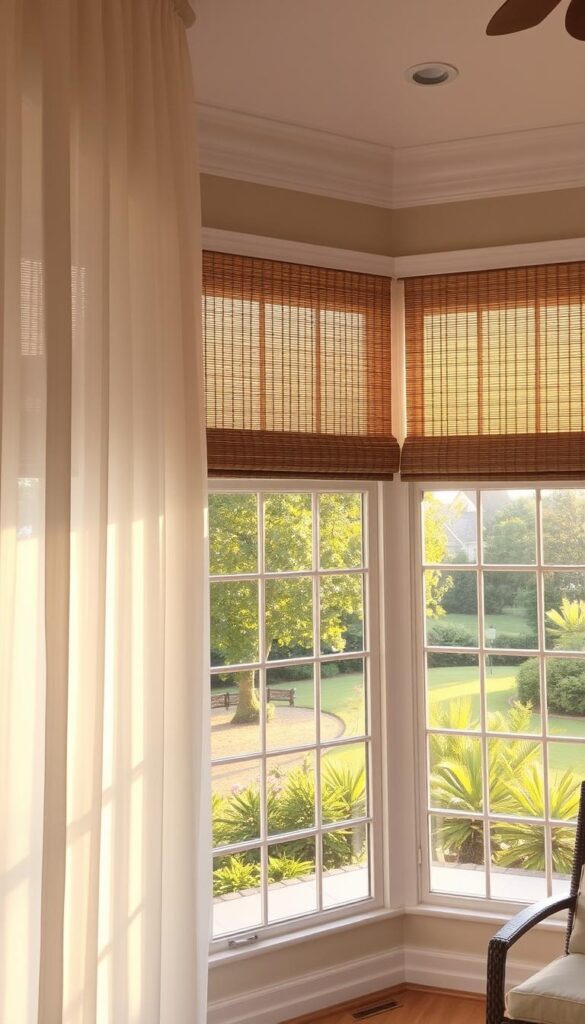
Seamless Drapery Solutions
Full-length sheer drapes offer an elegant compromise—filtering harsh rays while preserving airy sightlines. Costa recommends unbleached linen varieties that soften glare without darkening the space. These lightweight fabrics move gently with breezes, adding organic rhythm to your decor.
Consider maintenance when selecting materials. Machine-washable cotton voile withstands frequent use, while moisture-resistant polyester blends suit humid climates. Renee often pairs neutral-toned curtains with bold tiebacks, proving practicality can coexist with visual intrigue.
For traditional settings, try relaxed Roman shades in grasscloth weaves. Modern spaces shine with motorized solar screens that disappear when fully raised. Both options maintain clean sightlines while offering adjustable light control—key for balancing afternoon brightness with evening ambiance.
Your treatments should complement existing architecture. Match drapery rods to window trim finishes, or contrast them for deliberate focal points. This thoughtful approach ensures your sunroom feels cohesive, whether you’re hosting summer gatherings or enjoying solitary mornings bathed in natural light.
How to Style a Summer-Inspired Sunroom
Transforming your sunroom into a summer retreat requires blending aesthetics with purpose. Consider spaces that balance airy minimalism with thoughtful details—like a coastal Maine project where woven pendant lights float above reclaimed teak benches. These choices honor the room’s connection to nature while serving daily needs.
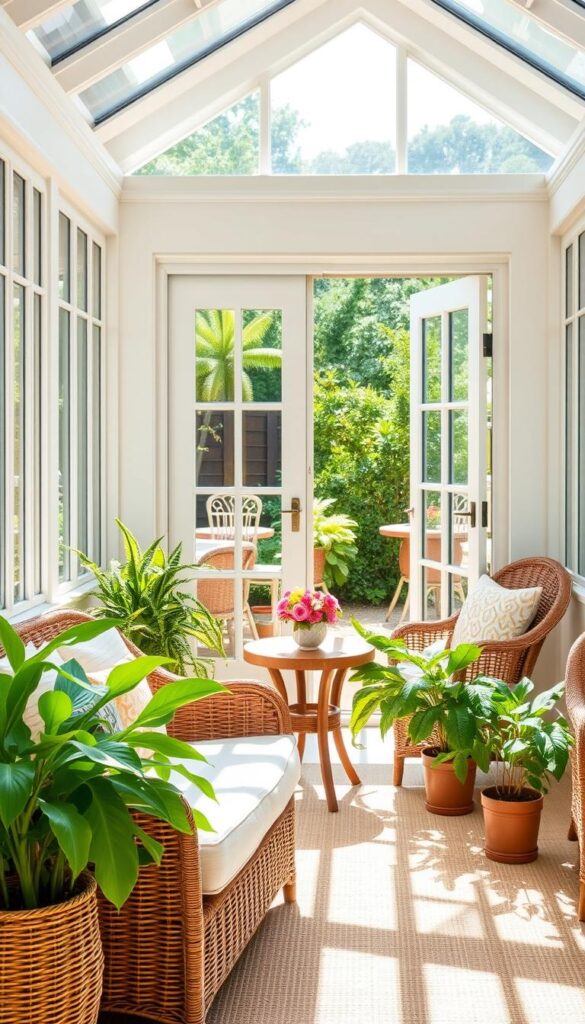
Showcase Design Inspirations
Draw from Mediterranean courtyards with terra-cotta planters spilling lavender and rosemary. A Palm Beach designer paired coral-hued accent walls with ivory slipcovers, proving bold color statements can coexist with relaxation. For smaller spaces, try folding bamboo screens that partition zones without blocking light flow.
Practical Styling Tips
Anchor seating areas with indoor-outdoor rugs that handle foot traffic and spills. Layer side tables with dual-purpose decor—coastal-inspired trays that corral remotes or hold iced tea glasses. Install floating shelves near windows to display potted succulents or vintage glassware collections.
Incorporate playful DIY elements like hand-painted driftwood mirrors or rope-wrapped curtain rods. These touches add personality without overwhelming sightlines. Remember: successful designs marry visual harmony with lived-in comfort, creating spaces that invite both lively gatherings and solitary reflection.
Enhance Outdoor-to-Indoor Flow
Blurring boundaries between environments turns your sunroom into a harmonious bridge for daily living. Designers like Trevor Tondro approach this challenge by crafting spaces that mirror outdoor rhythms while maintaining interior comfort. Imagine stepping from your patio into a room that feels like a natural extension of the landscape.
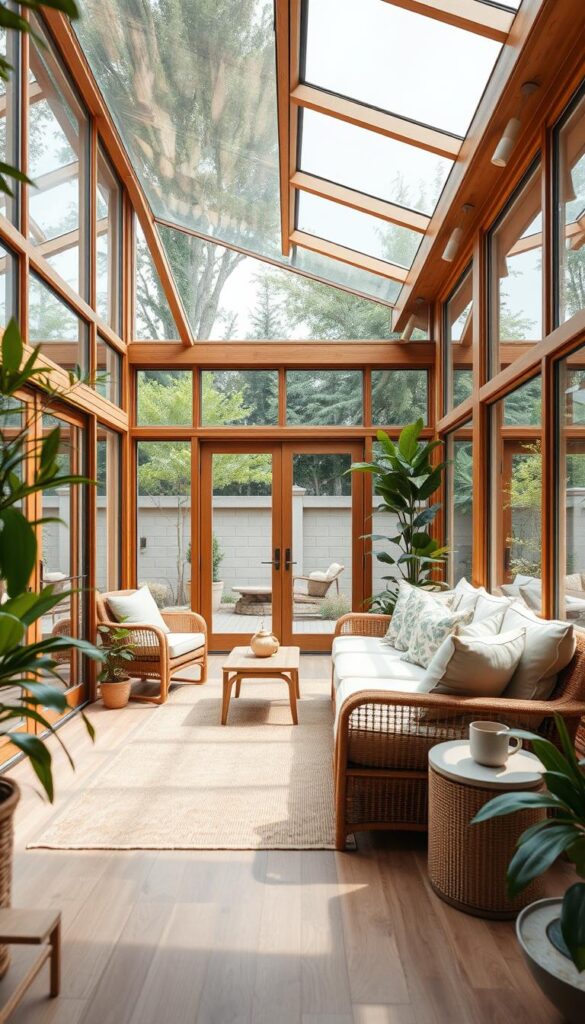
Seamless Transition Ideas
Start by aligning flooring materials. Continuity matters—using similar stone tiles or wood planks indoors and out creates visual flow. Many homeowners extend their patio’s bluestone into the sunroom, then layer with jute rugs for subtle differentiation. This approach makes both spaces feel intentionally connected.
Furniture placement guides movement. Position a curved sectional so it faces both the garden and interior, encouraging guests to transition smoothly. Custom built-in benches along windows work double duty—providing seating while framing views of your backyard oasis.
Consider flexible dining setups. A teak table placed near sliding doors can serve indoor meals or alfresco gatherings. Designers often use matching ceramic planters inside and outside windows, reinforcing the theme of continuity. For summer evenings, string Edison bulbs from the sunroom’s ceiling to nearby trees, creating a luminous pathway.
Small details matter most. Match cushion fabrics to outdoor throw pillows, or repeat a signature color in both spaces’ accent pieces. These thoughtful touches make your home feel unified yet dynamic, perfect for savoring warm-weather moments.
Introduce Playful Details and Nautical Touches
Coastal charm thrives in sunrooms through clever nods to maritime life. Designer Laurey Glenn suggests balancing sophistication with whimsy by anchoring your space with authentic nautical elements. Think of brass porthole mirrors or rope-wrapped table legs that whisper of harbor days without shouting “theme park.”
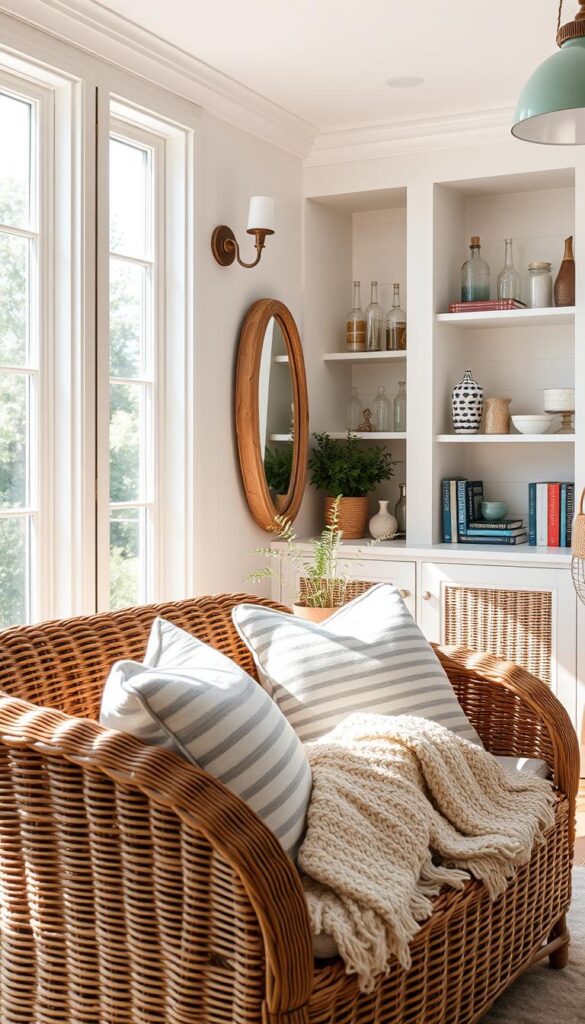
Incorporate Maritime Elements
Boat cleats make unexpected curtain tiebacks, while vintage oars hung horizontally create artful wall displays. For subtle texture, try sisal rugs resembling dock ropes under a wicker coffee table. Glenn often uses navy-and-white striped cushions on porch swings to evoke yacht club vibes—pair these with weathered teak side tables for coastal authenticity.
Creative DIY Craft Ideas
Transform thrift store finds into bespoke decor. Paint an old fan blade with compass rose motifs, or stencil anchor patterns onto plain lampshades. Upcycle wooden crates into floating shelves for displaying seashell collections or potted succulents. These projects add personality while keeping your budget anchored.
Maintain visual balance by limiting bold accents to one wall or corner. A single painted paddle above a reading chair or clustered glass buoys on a windowsill injects character without clutter. Remember: the goal is to suggest coastal life, not recreate a ship’s cabin. Let sunlight highlight your curated details, creating a room that feels both intentional and effortlessly breezy.
Add Functional Game and Entertainment Areas
Sunrooms naturally invite laughter and connection when designed for playful gatherings. The Nantucket Looms project demonstrates this beautifully—their layout pairs a built-in checkers table with deep-cushioned loveseats, proving entertainment zones can balance function and comfort.
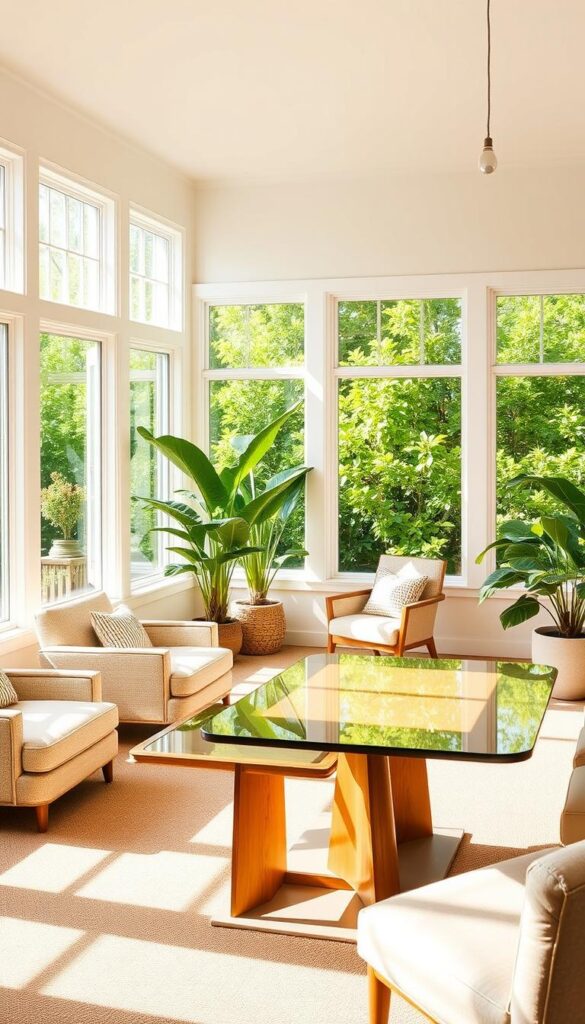
Start by defining zones. Position game tables near windows to leverage natural light, while keeping seating clusters within easy reach. A compact foosball table doubles as a conversation piece when flanked by weather-resistant armchairs. For smaller spaces, wall-mounted chess boards or fold-down ping-pong tables maximize versatility.
Blend aesthetics with practicality. Store board games in woven baskets that complement rattan furniture, or display vintage puzzles on floating shelves as decor. Many homeowners find success with convertible pieces—ottomans that become drink stations, or coffee tables with hidden storage for game pieces.
Consider daytime-to-evening transitions. Install adjustable pendant lights above game areas for focused illumination after sunset. The key lies in creating a multi-purpose space that adapts effortlessly—morning coffee spot by day, lively entertainment hub by night. Explore inventive game room ideas that maintain your sunroom’s airy feel while adding dynamic energy.
Successful designs honor the room’s primary role while inviting spontaneity. A Connecticut family transformed their sunroom’s corner into a mini-arcade with retro stools and a neon sign, proving even bold additions can feel harmonious. Let your space evolve organically—after all, the best gatherings often happen where fun and function intersect.
Curate an Inviting Dining Space in Your Sunroom
A well-designed dining area turns your sunroom into a versatile extension of your home. Take inspiration from White Arrows’ project, where movable furniture transforms the space from cozy breakfast nook to festive gathering spot. The key lies in balancing practicality with aesthetic charm—creating a setting that feels both intentional and adaptable.
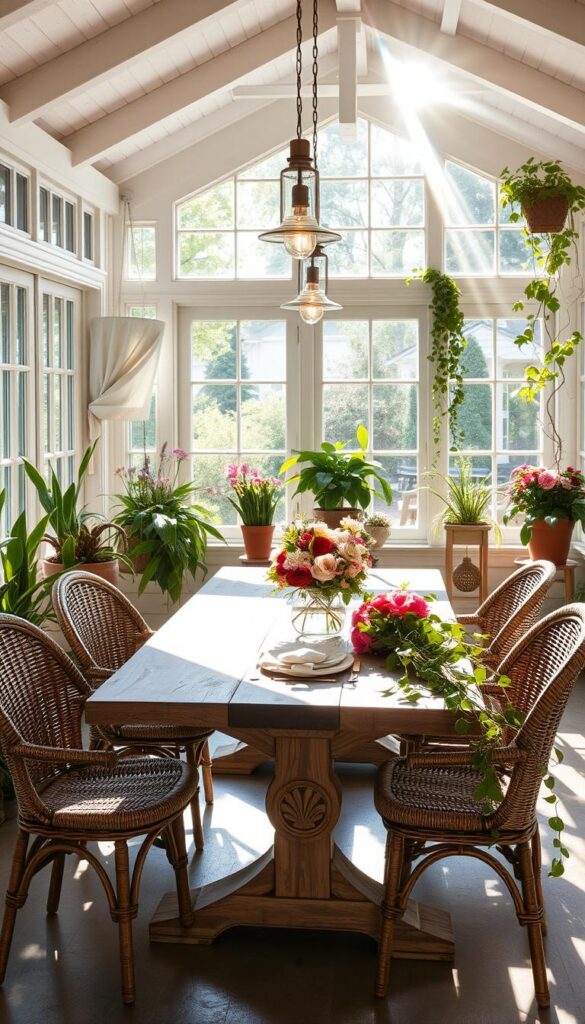
Flexible Table Arrangements
Choose tables that evolve with your needs. Extendable teak designs accommodate impromptu guests, while modular ottoman systems double as casual seating or footrests. Durable surfaces matter—tempered glass resists heat rings, and powder-coated metal legs withstand humidity shifts common in these bright spaces.
Accessorize thoughtfully. Melamine dishes in earthy tones bring sophistication without fragility. Layer mix-and-match linen napkins for effortless texture, then anchor the table with a low succulent centerpiece. These elements maintain visual interest while simplifying cleanup after al fresco meals.
Blur boundaries by aligning your dining layout with adjacent patios. Folding doors create seamless transitions for summer soirées, letting conversations flow between areas. For everyday use, position chairs to capture garden views—turning morning coffee into a sensory experience.
Remember: successful designs marry form and function. A rattan pendant light adds organic warmth above the table, while washable seat cushions in sun-resistant fabrics ensure lasting comfort. This approach crafts a space that feels lived-in yet polished, ready for everything from family dinners to sunset wine tastings.
Play With Textures and Layering Trends
Texture transforms rooms from flat to fascinating through intentional layering. Designers like Leanne Ford showcase how tactile contrasts add depth while maintaining visual harmony. In sunrooms, this approach balances organic warmth with refined elegance—think woven jute rugs softening sleek metal frames or linen drapes framing glossy ceramic vases.
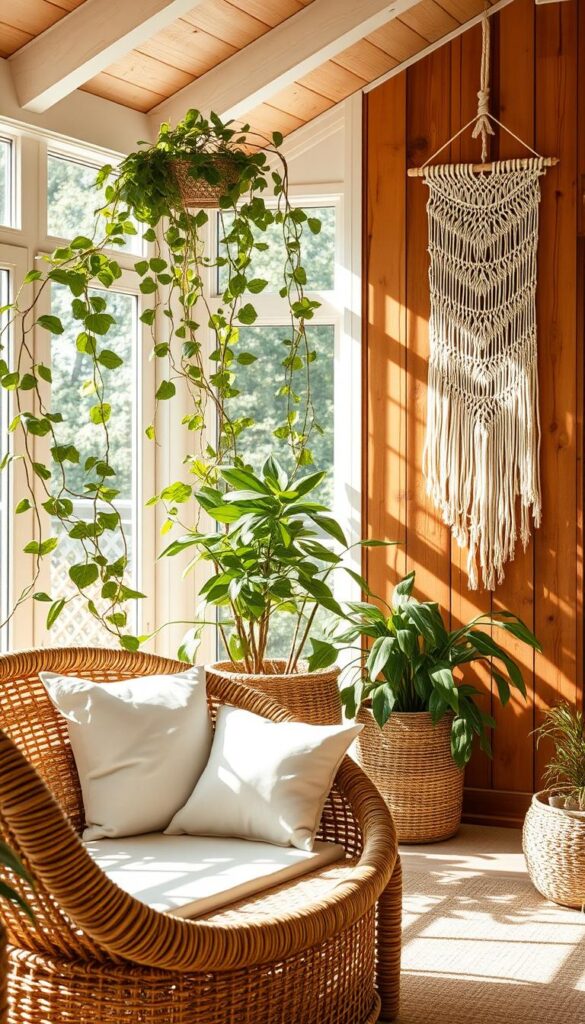
Mixing Fabrics and Finishes
Start with foundational pieces that anchor your design. A velvet-upholstered bench paired with airy cotton curtains creates instant contrast. Designer Mark D. Sikes often layers chunky knit throws over smooth leather chairs, proving textural interplay elevates comfort and sophistication.
Experiment with material pairings beyond fabrics. Try a matte concrete side table beneath a high-gloss pendant light—this duo reflects light differently throughout the day. For cohesive contrast, repeat one color across varied textures, like sage green in embroidered pillows and glazed pottery.
Practicality guides successful layering. Choose machine-washable linen slipcovers for sofas, then add delicate lace accent pillows. This blend ensures durability meets delicacy. Many designers use nubby wool rugs to ground spaces with rattan furniture, creating inviting tension between rough and refined elements.
Balance remains key. Limit bold patterns to one or two items, letting textures shine through neutral tones. A sisal basket holding woven blankets beside a sleek glass coffee table demonstrates how opposing materials can coexist beautifully. These ideas prove thoughtful layering turns functional spaces into multi-sensory retreats.
Mix Vintage and Modern Elements
Blending eras in your sunroom creates a dialogue between past and present. Designers like Amber Lewis demonstrate this through curated pairings—a 1940s rattan chair beside a sleek concrete coffee table, for instance. These combinations add depth while maintaining airiness.
Start with one statement vintage piece per zone. A restored pie safe makes an elegant media console when paired with contemporary modular sofa. Look for aged items with clean lines that echo your modern sunroom’s architecture. Wicker armchairs from the 1970s work beautifully against crisp white walls.
Balance is key. Follow Studio McGee’s approach:
- Use neutral-toned vintage items to avoid visual competition
- Pair ornate frames with minimalist abstract art
- Anchor floral-patterned pillows with solid-colored furniture
Texture bridges time gaps effectively. Try a nubby wool throw over smooth leather cushions, or place hammered brass lamps on lacquered side tables. These contrasts feel intentional rather than accidental.
Limit bold colors to newer pieces. A vibrant modern rug can energize faded wooden beams without overwhelming. Remember: successful blending celebrates beauty across generations while keeping your space functional for daily life.
Use Art and Decorative Accents for Drama
Art becomes the soul of a sunroom when curated with intention. A bold textile wall hanging or oversized ceramic vase can anchor the room’s energy while reflecting your personal narrative. Consider how light interacts with pieces—morning sun might illuminate a bronze sculpture differently than dusk’s golden glow.
Statement Wall Ideas
Transform blank walls into conversation starters. A Palm Springs homeowner paired lime-washed plaster with floating shelves displaying abstract clay forms. This approach merges texture with functionality—rough surfaces catch shifting light, while curated objects add depth.
Try these materials for impact:
- Reclaimed wood planks stained in driftwood tones
- Textured grasscloth wallpaper with metallic threads
- Geometric tile patterns in terracotta and cream
Decorative accents set the room’s rhythm. In a New England cottage, navy-blue shutters frame windows adorned with hand-blown glass suncatchers. These elements work harmoniously—the crisp color grounds the space while translucent ornaments scatter rainbows across walls during peak daylight.
When selecting art, consider scale and theme. A oversized botanical print above a wicker loveseat brings nature indoors without competing with garden views. For seasonal flexibility, rotate framed textile art—linen in summer, wool in autumn—to mirror the changing landscape beyond your windows.
Balance remains crucial. Limit bold wall treatments to one focal area, complementing them with simpler furnishings. A Chicago designer achieved this by pairing a mural of abstract dunes with neutral linen curtains and a weathered oak console. The result? A space that whispers drama rather than shouts it.
Choose Durable and Easy-to-Clean Materials
Material selection shapes your sunroom’s longevity as much as its beauty. Ariel Okin’s layered approach demonstrates how weather-resistant surfaces can coexist with inviting textures. Think of wicker furniture paired with Sunbrella fabric cushions—combining organic charm with stain-repellent practicality.
Materials That Resist Weather
Sunrooms demand surfaces that laugh at spilled lemonade and afternoon showers. Powder-coated metal side tables shrug off humidity, while ceramic tile floors handle muddy paws with ease. These choices prove resilience doesn’t require sacrificing style—a lesson from coastal homes where salt air tests every material’s limits.
Natural fibers like rattan and teak age gracefully when properly sealed. Treat them annually with UV-protective oils to maintain their golden hues. For seating, opt for foam cores wrapped in outdoor-rated polyester—they retain shape through summer’s heat without fading.
Balance comfort and practicality. Layer machine-washable cotton throws over synthetic rattan sofas. Use tempered glass coffee tables to protect wood surfaces from condensation rings. These smart pairings let your space evolve with the seasons while staying effortlessly maintained.
Simple care extends your materials’ lifespan. Wipe down surfaces weekly with pH-neutral cleaners, and rotate cushions to ensure even sun exposure. With thoughtful choices, your sunroom becomes a low-maintenance sanctuary that welcomes bare feet and ice-cold sweet tea for years.
Adapt Your Space for Seasonal Transitions
Seasonal shifts invite opportunities to reimagine your sunroom’s purpose and atmosphere. Designers like Nate Berkus showcase how adaptable spaces maintain relevance through changing weather, blending summer’s airy energy with winter’s cozy intimacy. Start by identifying elements that serve dual roles—like storage ottomans holding lightweight throws in July and chunky knits by December.
From Bright Summer to Cozy Winter
Swap breezy linen cushions for wool-blend covers as temperatures drop. Layer jute rugs with thicker woven options during colder months—this adds warmth while preserving texture contrast. Install adjustable curtain rods to accommodate heavier drapes in winter without permanent hardware changes.
Rotate decor accents seasonally. A ceramic vase filled with dried grasses in autumn transitions effortlessly to fresh eucalyptus stems come spring. These subtle shifts keep the room feeling current without overwhelming visual continuity.
Future-Proof Your Design
Choose neutral foundations that anchor bold seasonal accents. A sand-colored sofa paired with removable slipcovers allows quick palette changes. Designers often use modular shelving units to display rotating art pieces or holiday-themed objects.
Consider these cost-effective updates:
- Magnetic plant holders for interchangeable greenery
- Interchangeable pillow covers with seasonal patterns
- Stackable side tables that expand for holiday gatherings
Smart planning ensures your space evolves naturally. Leave intentional blank areas on walls for temporary installations, or dedicate one corner to a convertible reading nook/dining area. With these strategies, your sunroom remains a year-round sanctuary that celebrates each season’s unique charm.
Conclusion
Your sunroom becomes a canvas where light and comfort paint daily moments of joy. Through thoughtful design choices, this versatile space evolves from morning retreat to evening gathering spot effortlessly. Remember: natural materials, layered textures, and adaptive furniture form the foundation of a beautiful sunroom that serves multiple roles in your home.
Balance remains key. Bold accents shine when paired with neutral foundations, while durable fabrics and weather-resistant surfaces ensure lasting appeal. Whether adding a modern sunroom table for casual meals or creating reading nooks bathed in golden light, prioritize solutions that blend aesthetics with everyday life.
Let these ideas spark your creativity. Your room should reflect personal rhythms while honoring its connection to nature. Start small—swap throw pillows, introduce a statement plant, or experiment with light-filtering curtains. Every adjustment brings you closer to a space that feels both intentional and inviting.
Now’s the time to reimagine possibilities. Gather inspiration from sun-dappled corners, then craft a sanctuary where memories unfold. Your ideal sunroom awaits—ready to transform ordinary moments into something extraordinary.


